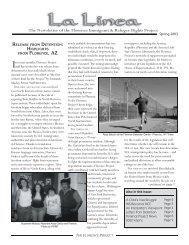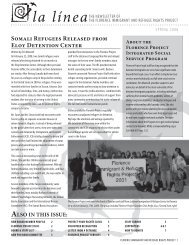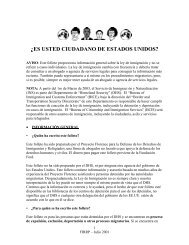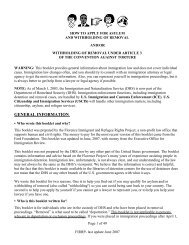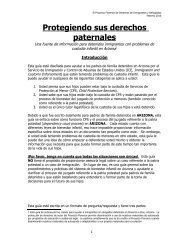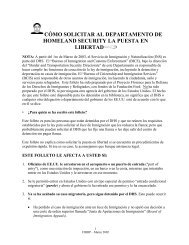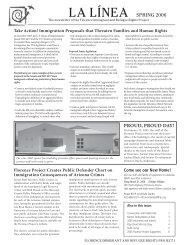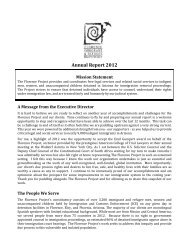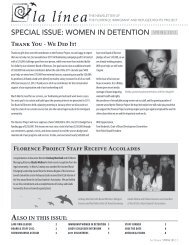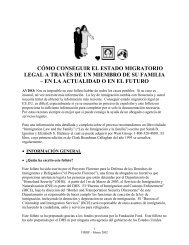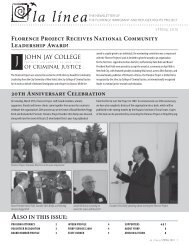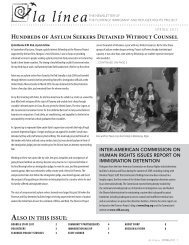quick reference chart and annotations for determining immigration ...
quick reference chart and annotations for determining immigration ...
quick reference chart and annotations for determining immigration ...
Create successful ePaper yourself
Turn your PDF publications into a flip-book with our unique Google optimized e-Paper software.
Immigrant Legal Resource Center, Florence Immigrant <strong>and</strong> Refugee Rights Project,<br />
Maricopa County Public Defender August 2012<br />
B. Burglary in the second degree is a class 3 felony.<br />
Summary: To avoid an aggravated felony, obtain a sentence of less than a year. To avoid a<br />
CMT, plead to intent to commit “theft or any felony.” To avoid possible exposure to the domestic<br />
violence ground, avoid identification of the domestic relationship in the record of conviction.<br />
Crime Involving Moral Turpitude: See discussion at ARS §13-1506, supra. To avoid a CMT,<br />
defense counsel should create a record of conviction where the client is guilty only of “theft or any<br />
felony” or “a felony.” (To determine whether an offense may be found turpitudinous in <strong>immigration</strong><br />
court, see Matter of Silva-Trevino, 24 I&N Dec. 687 (A.G. 2008).) The BIA has also found that burglary<br />
of an occupied dwelling is a CMT regardless of the underlying crime. Matter of Louissaint, 24 I&N Dec.<br />
754 (BIA 2009). However, the definition of a “residential structure” under Arizona law includes<br />
dwellings that are not occupied. ARS § 13-1501(11). Counsel should attempt to plead to burglary of an<br />
unoccupied dwelling or leave the record vague as to whether the residence was occupied at the time of the<br />
burglary.<br />
Aggravated Felony as Burglary: See ARS §13-1506.<br />
Aggravated Felony as a Crime of Violence: Generally, felony burglary of a dwelling is a<br />
“crime of violence” under 18 USC § 16(b), because of the inherent risk that the burglar will encounter the<br />
resident <strong>and</strong> violence will ensue. A conviction of a crime of violence is an aggravated felony if a<br />
sentence of a year or more is imposed. To avoid this possibility, counsel should make every attempt to<br />
obtain a sentence of 364 days or less <strong>for</strong> each individual count.<br />
If that is not possible, however, counsel can provide <strong>immigration</strong> attorneys with an argument that<br />
the offense is not a crime of violence if the record leaves open the possibility (a) that no <strong>for</strong>ce was used<br />
against the property (e.g., a window was not broken to gain entrance) <strong>and</strong> (b) the dwelling was not<br />
occupied at the time (meaning that it was not currently rented or lived in, as opposed to that the occupant<br />
was not at home). Regarding the latter point, the Arizona definition of dwelling includes an unoccupied<br />
dwelling, See U.S. v. Martinez-Martinez, 468 F.3d 604 (9th Cir. 2006), Immigration counsel have a<br />
good argument that there is no inherent risk that a confrontation will ensue <strong>and</strong> <strong>for</strong>ce will be used in the<br />
burglary of a residential structure that is not inhabited.<br />
Where a sentence of a year or more is imposed, counsel also must ensure that the record does not<br />
establish that the offense is an aggravated felony as “burglary”; see above section.<br />
Aggravated Felony as Attempted Theft. Conviction of an attempt to commit an offense<br />
involving theft may be an aggravated felony if a sentence of one year or more is imposed. The Ninth<br />
Circuit has held that a conviction <strong>for</strong> entering a locked vehicle with the intent to commit theft constitutes<br />
an aggravated felony if the sentence is 365 days or more. Ngaeth v. Mukasey, 545 F.3d 796, 802 (9th Cir.<br />
2008). There<strong>for</strong>e, any plea in which a “substantial step” is taken in order to commit theft may be an<br />
aggravated felony. Defense counsel should avoid <strong>reference</strong> to entry of any “locked” structure <strong>and</strong> keep<br />
the record of conviction clear of what the intended crime was, i.e., plead to “theft or any felony” in the<br />
disjunctive, or to “any felony.” Immigration counsel can point to Ninth Circuit decisions holding that<br />
Arizona theft is broader than the generic definition of theft, <strong>and</strong> even if the record of conviction reveals<br />
that defendant intended to commit “any theft” it is unclear whether it was theft of services or theft of<br />
property, or whether any intent to deprive the owner was involved.<br />
Arizona Criminal Chart with Explanatory Endnote – August 2012<br />
48



